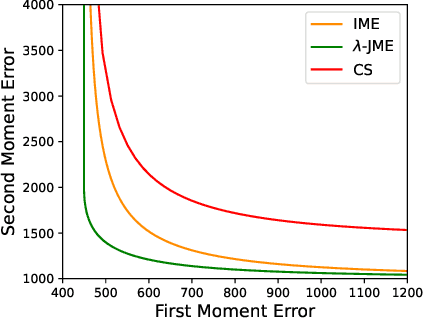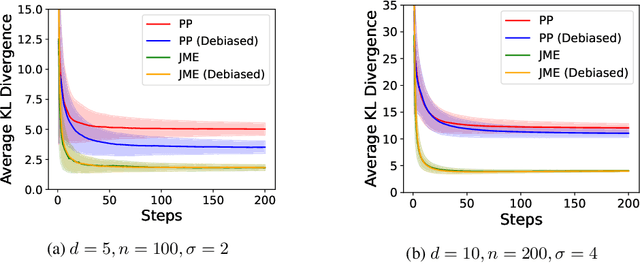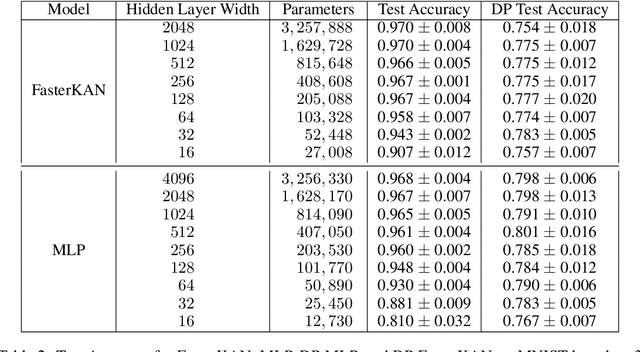Nikita P. Kalinin
Normalized Square Root: Sharper Matrix Factorization Bounds for Differentially Private Continual Counting
Sep 17, 2025Abstract:The factorization norms of the lower-triangular all-ones $n \times n$ matrix, $\gamma_2(M_{count})$ and $\gamma_{F}(M_{count})$, play a central role in differential privacy as they are used to give theoretical justification of the accuracy of the only known production-level private training algorithm of deep neural networks by Google. Prior to this work, the best known upper bound on $\gamma_2(M_{count})$ was $1 + \frac{\log n}{\pi}$ by Mathias (Linear Algebra and Applications, 1993), and the best known lower bound was $\frac{1}{\pi}(2 + \log(\frac{2n+1}{3})) \approx 0.507 + \frac{\log n}{\pi}$ (Matou\v{s}ek, Nikolov, Talwar, IMRN 2020), where $\log$ denotes the natural logarithm. Recently, Henzinger and Upadhyay (SODA 2025) gave the first explicit factorization that meets the bound of Mathias (1993) and asked whether there exists an explicit factorization that improves on Mathias' bound. We answer this question in the affirmative. Additionally, we improve the lower bound significantly. More specifically, we show that $$ 0.701 + \frac{\log n}{\pi} + o(1) \;\leq\; \gamma_2(M_{count}) \;\leq\; 0.846 + \frac{\log n}{\pi} + o(1). $$ That is, we reduce the gap between the upper and lower bound to $0.14 + o(1)$. We also show that our factors achieve a better upper bound for $\gamma_{F}(M_{count})$ compared to prior work, and we establish an improved lower bound: $$ 0.701 + \frac{\log n}{\pi} + o(1) \;\leq\; \gamma_{F}(M_{count}) \;\leq\; 0.748 + \frac{\log n}{\pi} + o(1). $$ That is, the gap between the lower and upper bound provided by our explicit factorization is $0.047 + o(1)$.
Back to Square Roots: An Optimal Bound on the Matrix Factorization Error for Multi-Epoch Differentially Private SGD
May 17, 2025Abstract:Matrix factorization mechanisms for differentially private training have emerged as a promising approach to improve model utility under privacy constraints. In practical settings, models are typically trained over multiple epochs, requiring matrix factorizations that account for repeated participation. Existing theoretical upper and lower bounds on multi-epoch factorization error leave a significant gap. In this work, we introduce a new explicit factorization method, Banded Inverse Square Root (BISR), which imposes a banded structure on the inverse correlation matrix. This factorization enables us to derive an explicit and tight characterization of the multi-epoch error. We further prove that BISR achieves asymptotically optimal error by matching the upper and lower bounds. Empirically, BISR performs on par with state-of-the-art factorization methods, while being simpler to implement, computationally efficient, and easier to analyze.
Binned Group Algebra Factorization for Differentially Private Continual Counting
Apr 06, 2025Abstract:We study memory-efficient matrix factorization for differentially private counting under continual observation. While recent work by Henzinger and Upadhyay 2024 introduced a factorization method with reduced error based on group algebra, its practicality in streaming settings remains limited by computational constraints. We present new structural properties of the group algebra factorization, enabling the use of a binning technique from Andersson and Pagh (2024). By grouping similar values in rows, the binning method reduces memory usage and running time to $\tilde O(\sqrt{n})$, where $n$ is the length of the input stream, while maintaining a low error. Our work bridges the gap between theoretical improvements in factorization accuracy and practical efficiency in large-scale private learning systems.
Continual Release Moment Estimation with Differential Privacy
Feb 10, 2025



Abstract:We propose Joint Moment Estimation (JME), a method for continually and privately estimating both the first and second moments of data with reduced noise compared to naive approaches. JME uses the matrix mechanism and a joint sensitivity analysis to allow the second moment estimation with no additional privacy cost, thereby improving accuracy while maintaining privacy. We demonstrate JME's effectiveness in two applications: estimating the running mean and covariance matrix for Gaussian density estimation, and model training with DP-Adam on CIFAR-10.
Notes on Sampled Gaussian Mechanism
Sep 06, 2024Abstract:In these notes, we prove a recent conjecture posed in the paper by R\"ais\"a, O. et al. [Subsampling is not Magic: Why Large Batch Sizes Work for Differentially Private Stochastic Optimization (2024)]. Theorem 6.2 of the paper asserts that for the Sampled Gaussian Mechanism - a composition of subsampling and additive Gaussian noise, the effective noise level, $\sigma_{\text{eff}} = \frac{\sigma(q)}{q}$, decreases as a function of the subsampling rate $q$. Consequently, larger subsampling rates are preferred for better privacy-utility trade-offs. Our notes provide a rigorous proof of Conjecture 6.3, which was left unresolved in the original paper, thereby completing the proof of Theorem 6.2.
DP-KAN: Differentially Private Kolmogorov-Arnold Networks
Jul 17, 2024



Abstract:We study the Kolmogorov-Arnold Network (KAN), recently proposed as an alternative to the classical Multilayer Perceptron (MLP), in the application for differentially private model training. Using the DP-SGD algorithm, we demonstrate that KAN can be made private in a straightforward manner and evaluated its performance across several datasets. Our results indicate that the accuracy of KAN is not only comparable with MLP but also experiences similar deterioration due to privacy constraints, making it suitable for differentially private model training.
 Add to Chrome
Add to Chrome Add to Firefox
Add to Firefox Add to Edge
Add to Edge